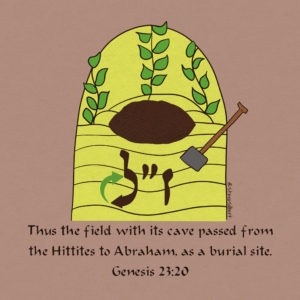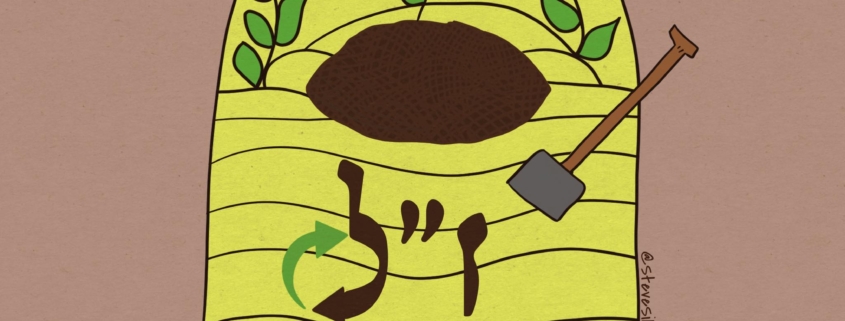Hayye Sarah: Return to the Earth
Part of an ongoing series that explores Torah through an ethic of social justice and building a world worthy of the Divine.
Parashat Hayye Sarah opens with the death of Sarah. After mourning and weeping over her body, Abraham approaches Ephron the Hittite to purchase land to bury her. Despite Ephron’s protests that he would give Abraham the field and the cave as a gift, Abraham insists that he pay Ephron the fair market value for the land. The story concludes with a verse indicating that once the purpose of the transaction has been carried out, Abraham takes legal possession of the cave as a burial site for Sarah and for future generations (Genesis 23:16-20).

וַיִּשְׁמַ֣ע אַבְרָהָם֮ אֶל־עֶפְרוֹן֒ וַיִּשְׁקֹ֤ל אַבְרָהָם֙ לְעֶפְרֹ֔ן אֶת־הַכֶּ֕סֶף אֲשֶׁ֥ר דִּבֶּ֖ר בְּאׇזְנֵ֣י בְנֵי־חֵ֑ת אַרְבַּ֤ע מֵאוֹת֙ שֶׁ֣קֶל כֶּ֔סֶף עֹבֵ֖ר לַסֹּחֵֽר׃ וַיָּ֣קׇם ׀ שְׂדֵ֣ה עֶפְר֗וֹן אֲשֶׁר֙ בַּמַּכְפֵּלָ֔ה אֲשֶׁ֖ר לִפְנֵ֣י מַמְרֵ֑א הַשָּׂדֶה֙ וְהַמְּעָרָ֣ה אֲשֶׁר־בּ֔וֹ וְכׇל־הָעֵץ֙ אֲשֶׁ֣ר בַּשָּׂדֶ֔ה אֲשֶׁ֥ר בְּכׇל־גְּבֻל֖וֹ סָבִֽיב׃ לְאַבְרָהָ֥ם לְמִקְנָ֖ה לְעֵינֵ֣י בְנֵי־חֵ֑ת בְּכֹ֖ל בָּאֵ֥י שַֽׁעַר־עִירֽוֹ׃ וְאַחֲרֵי־כֵן֩ קָבַ֨ר אַבְרָהָ֜ם אֶת־שָׂרָ֣ה אִשְׁתּ֗וֹ אֶל־מְעָרַ֞ת שְׂדֵ֧ה הַמַּכְפֵּלָ֛ה עַל־פְּנֵ֥י מַמְרֵ֖א הִ֣וא חֶבְר֑וֹ בְּאֶ֖רֶץ כְּנָֽעַן׃ וַיָּ֨קׇם הַשָּׂדֶ֜ה וְהַמְּעָרָ֧ה אֲשֶׁר־בּ֛וֹ לְאַבְרָהָ֖ם לַאֲחֻזַּת־קָ֑בֶר מֵאֵ֖ת בְּנֵי־חֵֽת׃
“Abraham paid out to Ephron the money that he had named in the hearing of the Hittites—four hundred shekels of silver at the going merchants’ rate. So Ephron’s land in Machpelah, near Mamre—the field with its cave and all the trees anywhere within the confines of that field—passed to Abraham as his possession, in the presence of the Hittites, of the assembly in his town’s gate. And then Abraham buried his wife Sarah in the cave of the field of Machpelah, facing Mamre—now Hebron—in the land of Canaan. Thus the field with its cave passed from the Hittites to Abraham, as a burial site.”
The concept of the purchase of land, which is then dedicated to make it holy for burial, is well-known in Jewish tradition. One of the first things a Jewish community is to establish, along with a mikvah and school, is a cemetery. Here in Atlanta, the Jewish section in Historic Oakland Cemetery was purchased in 1860.
I personally struggle with the idea that Jewish burial must take place in a designated Jewish cemetery, and have been exploring the feasibility of Jewish-Green burial as a way of balancing Jewish values of conservation and environmental justice.
Green burial overlaps with many traditional Jewish burial customs. In both, the deceased is not embalmed and is wrapped in a shroud. In Green burial there may be a biodegradable casket or no casket, while the prevailing Jewish custom in the U.S. is to use an unlined wooden casket. As in ancient Israel, in modern Israel there is no casket.
Georgia law permits the burial of human remains without a casket and the Jewish Funeral Home will prepare the deceased for a shroud-only burial. Still, I had never attended, let alone officiated at, a burial without a casket.
While many Green burials in the U.S. take place in natural cemeteries that are not set aside as holy ground, quite a few are designated as protected land. These are two I’ve researched the most: Honey Creek Woodlands in Conyers, GA, which is protected by a conservation easement held by a private, nonprofit land trust, and Greensprings Natural Cemetery Preserve in Newfield, NY, which offers ecological burials in meadows surrounded by 8,000 acres of protected forests.
I’m most familiar with Honey Creek Woodlands, because I officiated at a Jewish-Green burial there in March 2020 for a 93 year old man. When his son first contacted me in November 2019 I knew very little about Green burial; his devotion to an environmentally sound and simple burial for his father convinced me to learn more.
What struck me the most about the burial at Honey Creek Woodlands was not the absence of a casket. It was the absence of machinery. Most of the mourners walked on a path through the woods to the grave site. Those who needed assistance were transported by a volunteer on a golf cart. The grave was dug by hand, by cemetery staff, and the shrouded body was lowered into the ground by mourners. There was no shoveling—only the gentle placing of handfuls of dirt by those who felt comfortable bending low and reaching partly into the grave.
The graves in most natural cemeteries are three feet deep; the shallow burial allows for more efficient decomposition of the body, an easier return to the earth. There are no concrete burial vaults, which are used in conventional cemeteries to create consistent spacing, provide stability to the ground above, and allow for maintenance of the grass. In many natural cemeteries, there are no elaborate monuments, only flat, natural stones and native shrubs and plants as markers.
I’ve come to believe that conservation of the land through Green burial is more aligned with Jewish values than is the designation of the land for traditional burials in Jewish cemeteries. The appeal of Green burial for me personally comes from a desire to leave less of a footprint in death than I did in life. When I return to the earth, I wish for my body to give back to the land, to heal a small spot of this planet, whether in a pine forest in Conyers, GA or in a meadow in Newfield, NY.
When our ancestor Abraham purchased the land for Sarah’s burial, his concern about paying fair market value to obtain it legally and publicly can be seen as motivated by his desire to live ethically among the Hittites, to honor Sarah’s life, and to preserve this burial site for future generations.
I am inspired by his example to live justly and lightly on the land, and in death to return to the earth.


Author, artist, and teacher Rabbi Pamela Jay Gottfried is a member of the Bayit board.
Illustration by Steve Silbert, lead builder for Visual Torah and Bayit Games.



